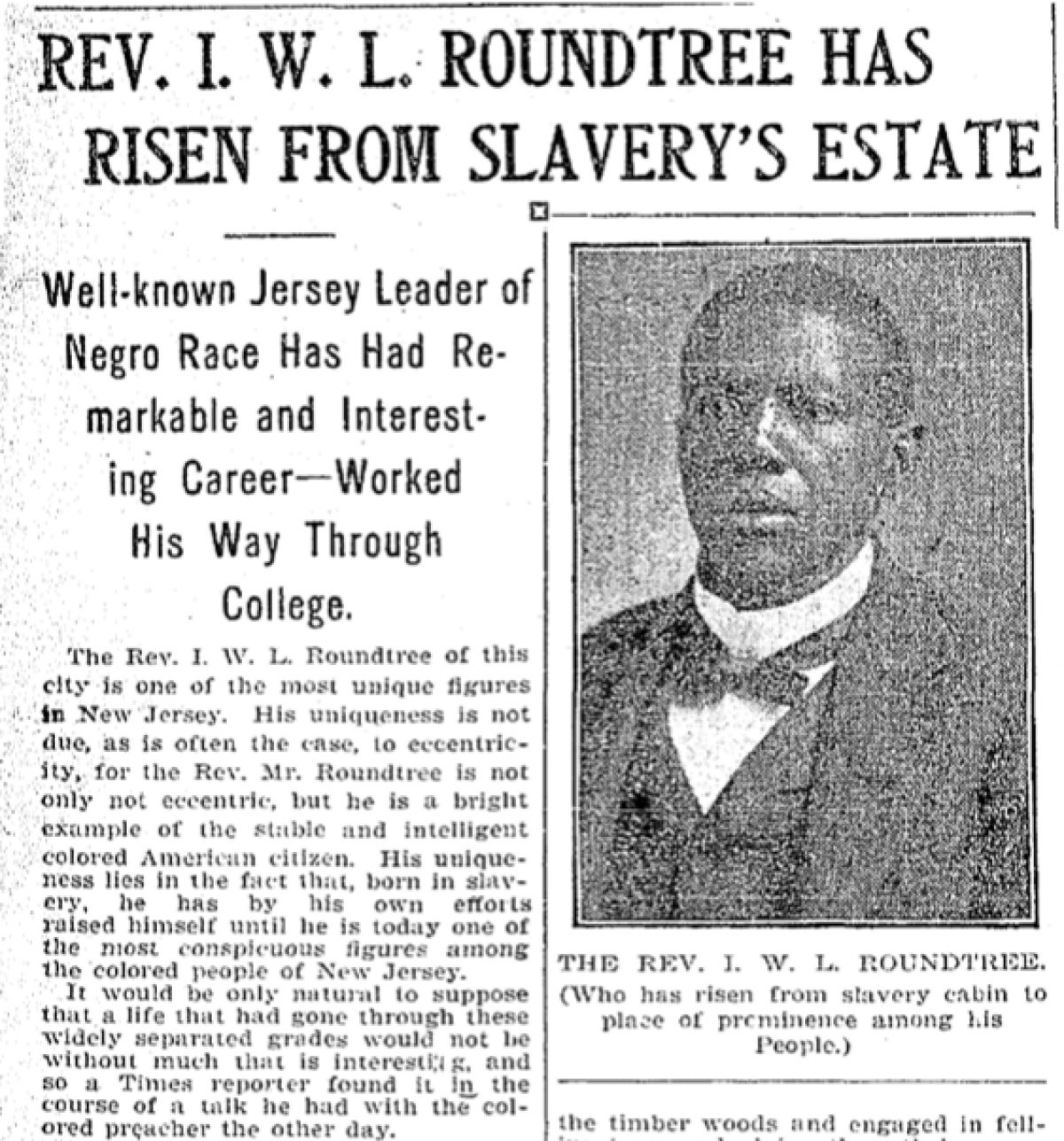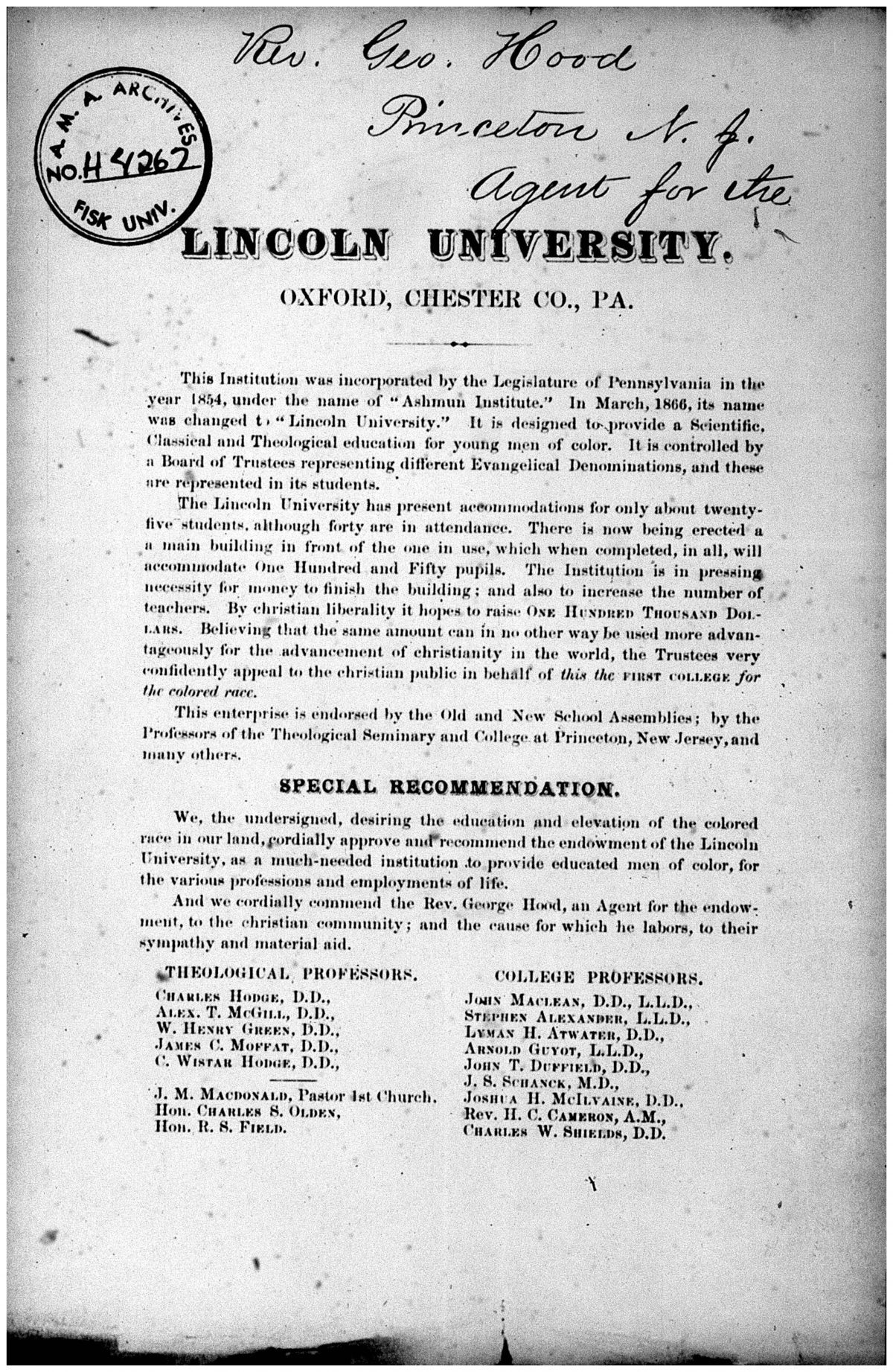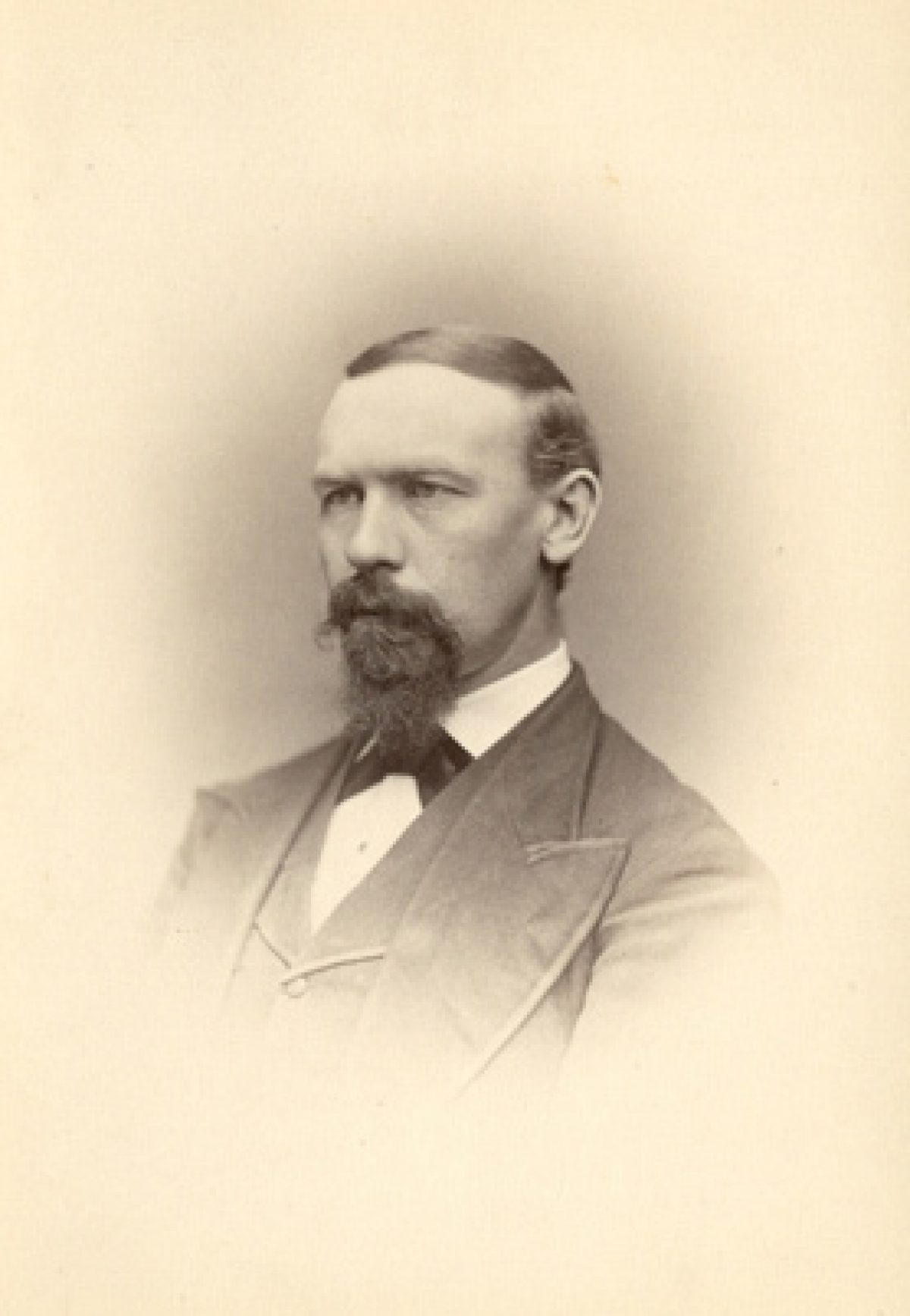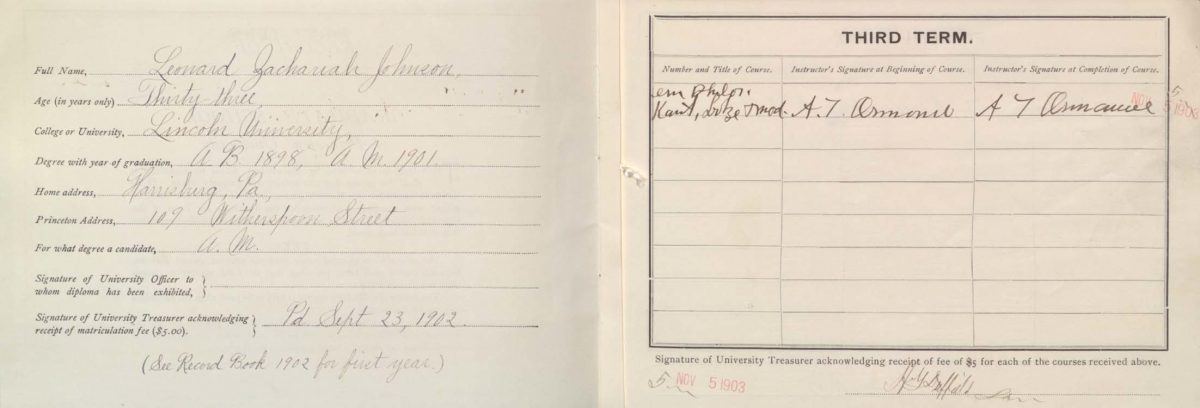[1]
Radcliffe Heermance to Bruce Wright, 13 June 1939, Box 73, Folder 6C, Historical Subject Files Collection, Princeton University Archives, Department of Rare Books and Special Collections, Princeton University.
⤴
[2]
See Thomas Jefferson Wertenbaker, Princeton 1746-1896 (Princeton, NJ: Princeton University Press, 1946), 288.
⤴
[3]
See also April C. Armstrong, “Integrating Princeton University: Robert Joseph Rivers ’53,” Princeton & Slavery Project, slavery.princeton.edu/stories/integrating-princeton-university-robert-joseph-rivers.
⤴
[4]
Kathryn Watterson, I Hear My People Singing: Voices of African American Princeton (Princeton: Princeton University Press, 2017), 259-260.
⤴
[5]
See Necrological Reports and Annual Proceedings of the Alumni Association of Princeton Theological Seminary, Vol. II (Princeton: O. S. Robinson & Co., 1899), 336-337.
⤴
[6]
“Rev. I. W. L. Roundtree Has Risen from Slavery’s Estate,” Trenton Times, 27 August 1904: 12.
⤴
[7]
“Johnson, Leonard Zachariah,” Box 6, Graduate School Academic Records, Princeton University Archives, Department of Rare Books and Special Collections, Princeton University; and “Stark, George Shippen,” Box 8, Graduate School Academic Records, Princeton University Archives, Department of Rare Books and Special Collections, Princeton University.
⤴
[8]
See Moorhead, Princeton Seminary, 22-26; Princetonian 5 October 1876: 3.
⤴
[9]
Board of Directors of Princeton Theological Seminary, quoted in James H. Moorhead, Princeton Seminary in American Religion and Culture (Grand Rapids, MI: Eerdmans, 2012), 83. Sources that claim Theodore Wright was also a graduate of the College of New Jersey appear to be in error.
⤴
[10]
See Thorp et al., The Princeton Graduate School, 51.
⤴
[11]
See, for example, Catalogue of Princeton University (1899): 30-31 and 90-91.
⤴
[13]
See William K. Brown, Rhinebeck, New York, letter to Howard W. Dodds, 30 June 1951, “Ormond, Alexander Thomas, Sr.,” Faculty and Professional Staff Files, Princeton University Archives, Department of Rare Books and Special Collections, Princeton University.
⤴
[14]
See Anderson, Presbyterianism, 174-176; and McCosh, quoted in Woodson, ed., The Works of Francis J. Grimké, x.
⤴
[15]
“The Death of Professor Ormond,” Princeton Alumni Weekly 14, no. 13 (22 December 1915): 1.
⤴
[16]
William T. Coleman, Jr. and Donald T. Bliss outline the strategy civil rights lawyers employed in Counsel for the Situation: Shaping the Law to Realize America’s Promise (Washington: Brookings Institution, 2010), 105-119. For more on the ways black graduate students paved the way for full integration in American higher education, see “JBHE Chronology of Major Landmarks in the Progress of African Americans in Higher Education,” Journal of Blacks in Higher Education 53 (Autumn 2006): 77-78; and John T. Hubbell, “The Desegregation of the University of Oklahoma, 1946-1950,” The Journal of Negro History 54, No. 4 (October 1972): 370-384.
⤴
[17]
See Axtell, The Making of Princeton University, 420; “Moss, Simeon,” Graduate School Academic Records, Princeton University Archives, Department of Rare Books and Special Collections, Princeton University.; “Simeon F. Moss *49,” Princeton Alumni Weekly 108, no. 5 (21 November 2007), 55; and “Toback, Sabra,” Graduate School Academic Records, Princeton University Archives, Department of Rare Books and Special Collections, Princeton University.
⤴
[18]
“Simeon F. Moss *49,” 55.
⤴
[19]
Unsigned carbon copy of Charles W. McAlpin, Princeton, New Jersey, to Moses Taylor Pyne, January 5, 1907, Box 44, Folder 3, Office of the Secretary Records, Princeton University Archives, Department of Rare Books and Special Collections, Princeton University.
⤴
[20]
Moses Taylor Pyne, New York, New York, to Charles W. McAlpin, January 7, 1907, Box 44, Folder 3, Office of the Secretary Records, Princeton University Archives, Department of Rare Books and Special Collections, Princeton University. My thanks to Sara Logue for telling me about this exchange between McAlpin and Pyne.
⤴
[21]
Woodrow Wilson, Ontario, Canada, letter to John Rogers Williams 2 September 1904, in The Papers of Woodrow Wilson 15, ed. Arthur S. Link (Princeton, NJ: Princeton University Press, 1973), 462. As Link notes, Wilson was probably referring to undergraduate admissions. Even so, not acknowledging African American graduate students is unlikely to have been a mere oversight. Wilson may have been attempting to establish a tradition rather than maintain it.
⤴
[22]
“Persons and Things,” Nassau Literary Magazine 25, no. 3 (1 December 1868): 197.
⤴
[23]
William Royal Wilder, Charles L. Williams, and Woodrow Wilson were all editors of the Princetonian at the time, and “W.” could refer to any of them. See “Editors,” Princetonian, 1 November 1877: 97.
⤴
[24]
Woodrow Wilson, draft of a letter to G. McArthur Sullivan, 3 December 1909, in The Papers of Woodrow Wilson 15, ed. Arthur S. Link (Princeton, NJ: Princeton University Press, 1973), 550.
⤴
[25]
W. Barksdale Maynard, Woodrow Wilson: Princeton to the Presidency (New Haven: Yale University Press, 2008), 71.
African American graduates were not the only ones whitewashed out of Princeton’s history during and after the Wilson administration. Stark had received his M.A. in 1906, the same year as Howard Edwards Gansworth did. Records indicate that Gansworth was the first Native American to receive a graduate degree from Princeton. He had previously earned his A.B. from Princeton in 1901, the year before Wilson ascended to the Princeton presidency (See “Gansworth, Howard Edwards,” Box 8, Graduate School Academic Records, Princeton University Archives, Department of Rare Books and Special Collections, Princeton University.; “Gansworth, Howard E.,” Box 298, Folder 10, Historical Subject Files, Seeley G. Mudd Manuscript Library, Princeton University; and “Gansworth, Howard Edwards,” Box 275, Undergraduate Alumni Records 1900-1920, Princeton University Archives, Department of Rare Books and Special Collections, Princeton University. See also April C. Armstrong, “Howard Edwards Gansworth and the ‘Indian Problem’ at Princeton,” Seeley G. Mudd Manuscript Library Blog, 10 August 2016, https://blogs.princeton.edu/mudd/2016/08/howard-edwards-gansworth-and-the-indian-problem-at-princeton.
A Cuban national, Evaristo Vicente de Montalvo, had graduated with the Class of 1897. “De Montalvo, Evaristo Vicente,” Box 244, Undergraduate Alumni Records 1748-1920, Princeton University Archives, Department of Rare Books and Special Collections, Princeton University. For more on de Montalvo, see Paul Kramer, “Princeton and the Spanish American War,” in The Best of PAW: 100 Years of the Princeton Alumni Weekly (Princeton, NJ: Princeton Alumni Weekly, 2000), 59-60.
A handful of Japanese students earned graduate degrees in the early 20th century, including at least three in 1906: Taketaro Nakagawa, Wachi Seki, and Hironari Senouye. See “Nakagawa, Taketaro,” “Seki, Wachi,” and “Senouye, Hironari,” all in Box 9, Graduate School Academic Records, Princeton University Archives, Department of Rare Books and Special Collections, Princeton University..
In addition to these students, a significant number of Chinese students earned undergraduate degrees at Princeton prior to World War I. See, for example, “Chinese Student Members in America on Increase,” Daily Princetonian, 16 November 1914, 3.
These students were undoubtedly exceptional for Princeton of the era, but their presence somewhat reshapes the image of the institution at the time in ways typically overlooked.
⤴
[26]
Hundreds of articles on Roundtree appeared in the Trenton Evening Times during his lifetime. In one, the Times said Roundtree “is perhaps more widely known in this section than any other colored clergyman.” “Rev. I. W. L. Roundtree,” Trenton Evening Times, 17 May 1899, 4.
⤴
[27]
For more on the lack of enthusiasm for graduate alumni by comparison to undergraduate alumni at Princeton, see Thorp et al., The Princeton Graduate School, 267-268.
⤴
[28]
Paul C. Kemeny, Princeton in the Nation’s Service: Religious Ideals and Educational Practice, 1868-1928 (New York: Oxford University Press, 1998), 167.
⤴
[29]
See Earle E. Coleman, Princeton, New Jersey, to Clarence G. Contee, 11 July 1974, Box 295, Folder 2, Historical Subject Files, Princeton University Archives, Department of Rare Books and Special Collections, Princeton University. Coleman did later find evidence confirming that Stewart had indeed enrolled at Princeton as a graduate student.
⤴
[30]
Earle E. Coleman, Princeton, New Jersey, to Robert K. Durkee, 17 September 1987, Box 295, Folder 2, Historical Subject Files, Princeton University Archives, Department of Rare Books and Special Collections, Princeton University.
⤴
[31]
Moses Taylor Pyne, New York, New York, to Charles W. McAlpin, January 7, 1907, Box 44, Folder 3, Office of the Secretary Records, Princeton University Archives, Department of Rare Books and Special Collections, Princeton University.
⤴
[32]
C. Vann Woodward, The Strange Career of Jim Crow (New York: Oxford University Press, 1955), 8.
⤴
[33]
Grace Elizabeth Hale, Making Whiteness: The Culture of Segregation in the South, 1890-1940 (New York: Vintage Books, 1999), 44.
⤴
[34]
Woodward, The Strange Career of Jim Crow, 47.
⤴








